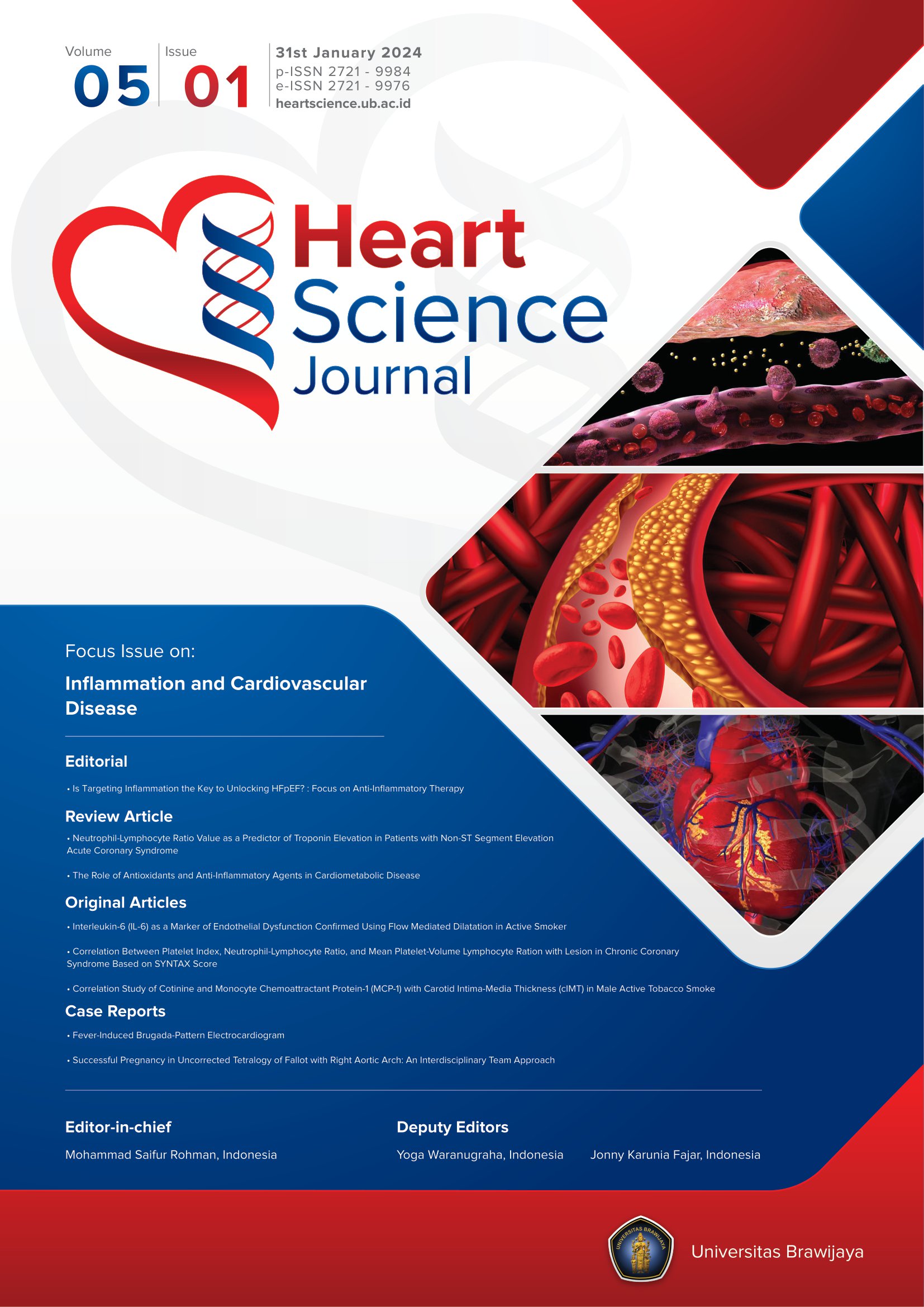Factors Associated with In-hospital Mortality in Patients with Acute Coronary Syndrome
Abstract
BACKGROUND: Acute coronary syndrome (ACS) remains major cause of death worldwide, therefore it is important to determine factors associated with worse outcomes to better elucidate which patients deserve a more aggressive approach for management.
OBJECTIVES: To describe the characteristics of patients admitted with ACS to Kediri General Hospital and factors associated with in-hospital mortality in ACS patients.
METHODS: In this cross-sectional study, 117 patients who admitted with ACS to Kediri General Hospital between January and June 2020 were included. Data were collected retrospectively from medical records and analyzed using SPSS software v25.
RESULTS: During hospitalization, 18 (15,4%) died. The bivariate analysis showed the patients who died were predominantly female, had higher prevalence of Killip IV, higher prevalence of clinical signs of heart failure, lower admission systolic and diastolic blood pressure, and higher heart rate. From multivariable analysis, variables which were significantly associated with in-hospital mortality were decreased consciousness (OR 11, 95% CI 1.327-92.4, p=0.026), and Killip class IV (OR 9.558, 95% CI 2.016-45.317).
CONCLUSION: Decreased consciousness and Killip class IV were associated with increased inhospital mortality in ACS.
KEYWORDS:In-hospital mortality, acute coronary syndrome, Killip class, Decrease of Conciousness
Keywords
Full Text:
PDFReferences
Chan MY, Shah BR, Gao F, Sim LL, Chua T, Tan HC, et al. Recalibration of the Global Registry of Acute Coronary Events risk score in a multiethnic Asian population. Am Heart J. 2011;162(2):291–9.
Ibanez B, James S, Agewall S, Antunes MJ, Bucciarelli-Ducci C, Bueno H, et al. 2017 ESC Guidelines for the management of acute myocardial infarction in patients presenting with ST-segment elevation. Eur Heart J. 2018;39(2):119–77.
Kataja A, Tarvasmäki T, Lassus J, Køber L, Sionis A, Spinar J, et al. Altered mental status predicts mortality in cardiogenic shock - results from the CardShock study. Eur Hear journal Acute Cardiovasc care. 2018;7(1):38–44.
El-Menyar A, Zubaid M, Almahmeed W, Sulaiman K, Alnabti A, Singh R, et al. Killip classification in patients with acute coronary syndrome: Insight from a multicenter registry. Vol. 30, American Journal of Emergency Medicine. 2012. p. 97–103.
Shah B, Baber U, Pocock S, Krucoff M, Ariti C, Gibson C. White blood cell count and major adverse cardiovascular events after percutaneous coronary intervention in the contemporary era insights from the Paris study (Patterns of non-adherence to anti-platelet regimens in stented patients registry). Circ Cardiovasc Interv. 2017;10(8):1–8.
Núñez J, Núñez E, Bertomeu V, Fácila L, Sanchis J, Bodí V. Prognostic value of baseline white blood cell count in patients with acute myocardial infarction and ST segment elevation. Heart. 2005;91(8):1094–5.
Lu H, Nordin R, Ahmad W, Lee C, Zambahari R, Ismail O, et al. Sex Differences in Acute Coronary Syndrome in a Multiethnic Asian Population. Glob Hear. 9(4):381–90.
DOI: https://doi.org/10.21776/ub.hsj.2022.003.01.6
Refbacks
- There are currently no refbacks.
Copyright (c) 2022 Hiradipta Ardining, Nisa Amnifolia Niazta, Muchammad Dzikrul Haq Karimullah

This work is licensed under a Creative Commons Attribution 4.0 International License.









